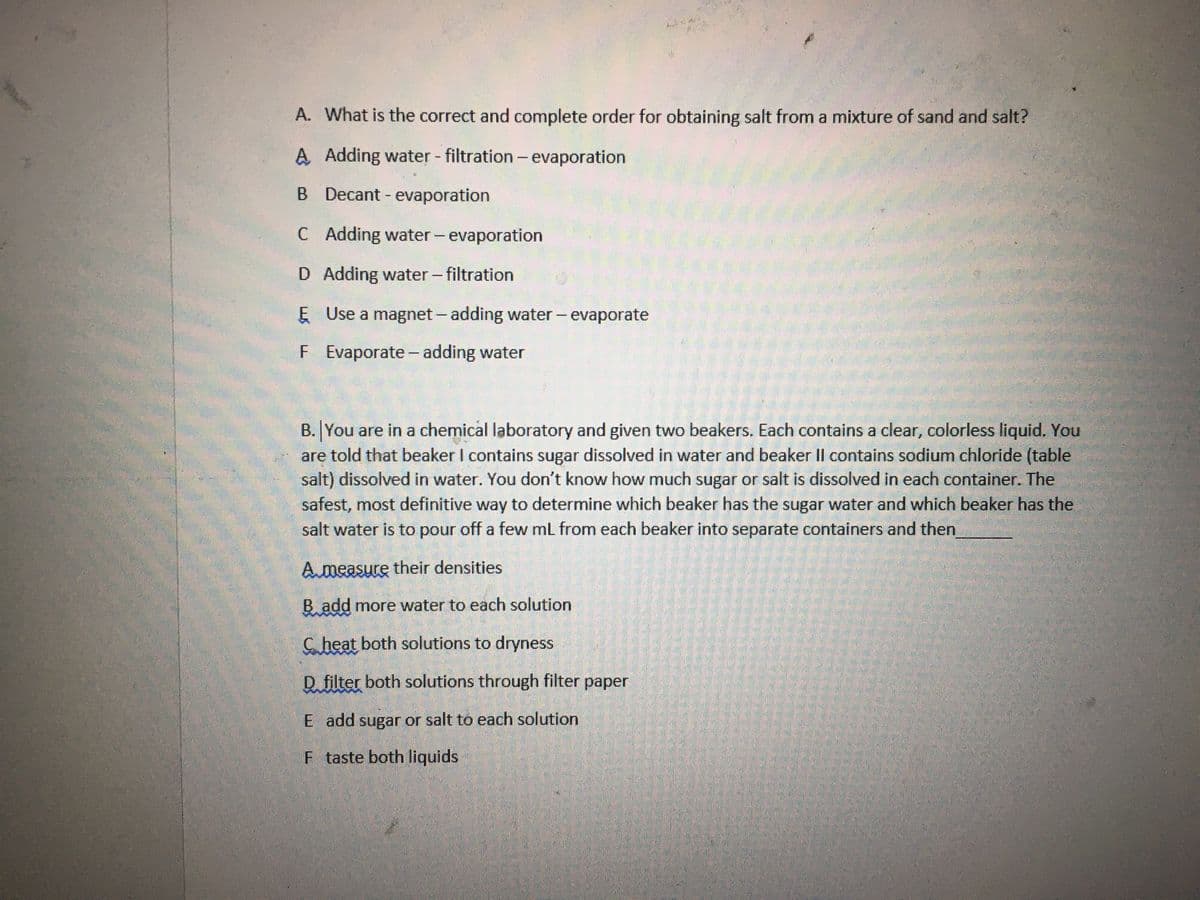A. What is the correct and complete order for obtaining salt from a mixture of sand and salt? A Adding water - filtration - evaporation B Decant - evaporation C Adding water - evaporation D Adding water - filtration E Use a magnet- adding water - evaporate F Evaporate -adding water B. You are in a chemical laboratory and given two beakers. Each contains a clear, colorless liquid. You are told that beaker I contains sugar dissolved in water and beaker IlI contains sodium chloride (table salt) dissolved in water. You don't know how much sugar or salt is dissolved in each container. The safest, most definitive way to determine which beaker has the sugar water and which beaker has the salt water is to pour off a few ml from each beaker into separate containers and then Ameasure their densities B add more water to each solution C heat both solutions to dryness D filter both solutions through filter paper E add sugar or salt to each solution F taste both liquids
A. What is the correct and complete order for obtaining salt from a mixture of sand and salt? A Adding water - filtration - evaporation B Decant - evaporation C Adding water - evaporation D Adding water - filtration E Use a magnet- adding water - evaporate F Evaporate -adding water B. You are in a chemical laboratory and given two beakers. Each contains a clear, colorless liquid. You are told that beaker I contains sugar dissolved in water and beaker IlI contains sodium chloride (table salt) dissolved in water. You don't know how much sugar or salt is dissolved in each container. The safest, most definitive way to determine which beaker has the sugar water and which beaker has the salt water is to pour off a few ml from each beaker into separate containers and then Ameasure their densities B add more water to each solution C heat both solutions to dryness D filter both solutions through filter paper E add sugar or salt to each solution F taste both liquids
Chemistry: An Atoms First Approach
2nd Edition
ISBN:9781305079243
Author:Steven S. Zumdahl, Susan A. Zumdahl
Publisher:Steven S. Zumdahl, Susan A. Zumdahl
Chapter7: Chemical Energy
Section: Chapter Questions
Problem 134IP: On Easter Sunday, April 3, 1983, nitric acid spilled from a tank car near downtown Denver, Colorado....
Related questions
Question
Can you please answer this two sub questions and show all of the steps to the solution

Transcribed Image Text:A. What is the correct and complete order for obtaining salt from a mixture of sand and salt?
A Adding water - filtration - evaporation
B Decant - evaporation
C Adding water - evaporation
D Adding water - filtration
E Use a magnet - adding water - evaporate
F Evaporate- adding water
B. You are in a chemical laboratory and given two beakers. Each contains a clear, colorless liquid. You
are told that beaker I contains sugar dissolved in water and beaker II contains sodium chloride (table
salt) dissolved in water. You don't know how much sugar or salt is dissolved in each container. The
safest, most definitive way to determine which beaker has the sugar water and which beaker has the
salt water is to pour off a few mL from each beaker into separate containers and then
Ameasure their densities
B add more water to each solution
C heat both solutions to dryness
D filter both solutions through filter paper
E add sugar or salt to each solution
F taste both liquids
Expert Solution
This question has been solved!
Explore an expertly crafted, step-by-step solution for a thorough understanding of key concepts.
This is a popular solution!
Trending now
This is a popular solution!
Step by step
Solved in 2 steps

Knowledge Booster
Learn more about
Need a deep-dive on the concept behind this application? Look no further. Learn more about this topic, chemistry and related others by exploring similar questions and additional content below.Recommended textbooks for you

Chemistry: An Atoms First Approach
Chemistry
ISBN:
9781305079243
Author:
Steven S. Zumdahl, Susan A. Zumdahl
Publisher:
Cengage Learning

Chemistry
Chemistry
ISBN:
9781305957404
Author:
Steven S. Zumdahl, Susan A. Zumdahl, Donald J. DeCoste
Publisher:
Cengage Learning


Chemistry: An Atoms First Approach
Chemistry
ISBN:
9781305079243
Author:
Steven S. Zumdahl, Susan A. Zumdahl
Publisher:
Cengage Learning

Chemistry
Chemistry
ISBN:
9781305957404
Author:
Steven S. Zumdahl, Susan A. Zumdahl, Donald J. DeCoste
Publisher:
Cengage Learning


Introductory Chemistry: An Active Learning Approa…
Chemistry
ISBN:
9781305079250
Author:
Mark S. Cracolice, Ed Peters
Publisher:
Cengage Learning

Chemistry: Matter and Change
Chemistry
ISBN:
9780078746376
Author:
Dinah Zike, Laurel Dingrando, Nicholas Hainen, Cheryl Wistrom
Publisher:
Glencoe/McGraw-Hill School Pub Co

Chemistry: The Molecular Science
Chemistry
ISBN:
9781285199047
Author:
John W. Moore, Conrad L. Stanitski
Publisher:
Cengage Learning